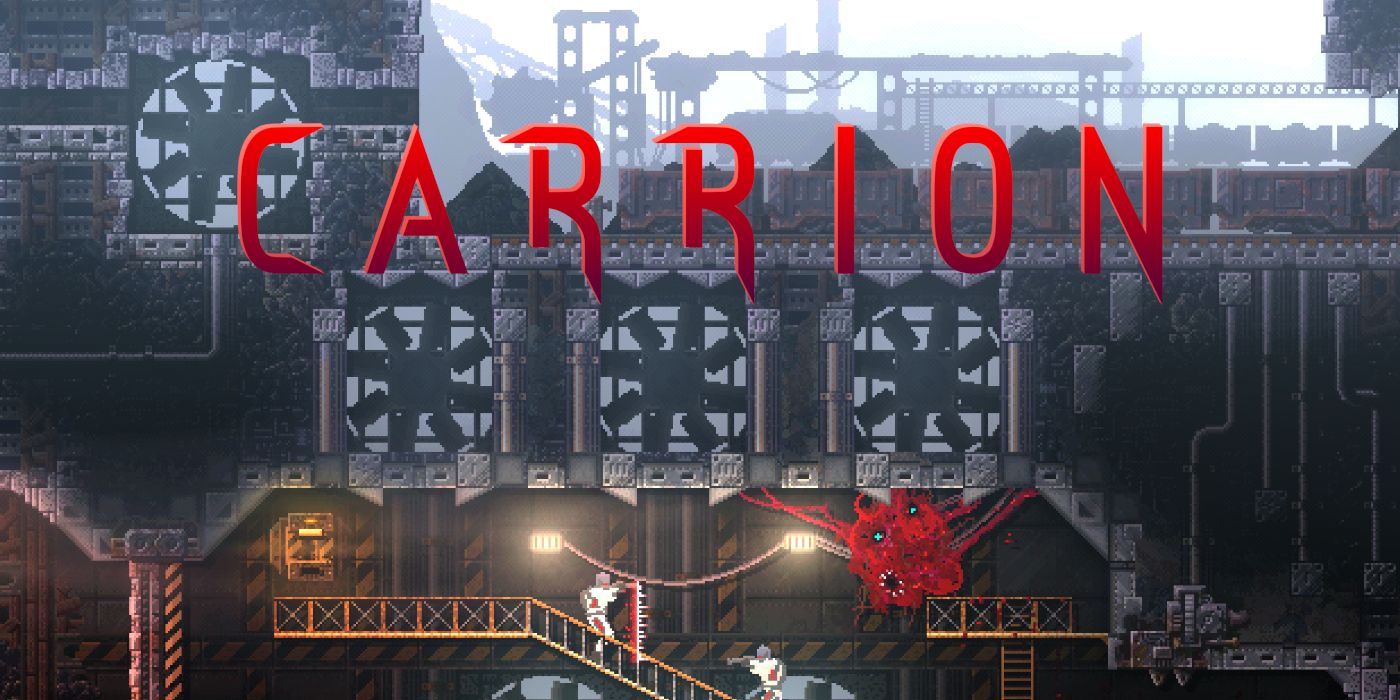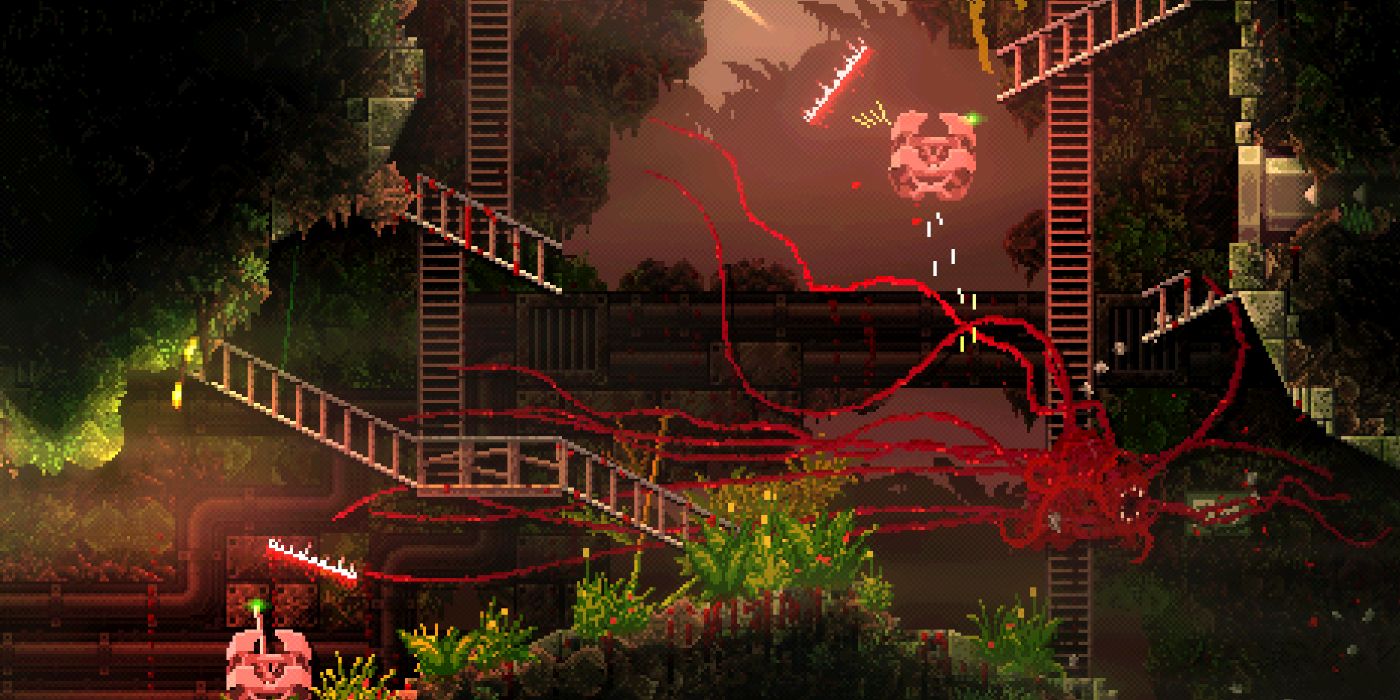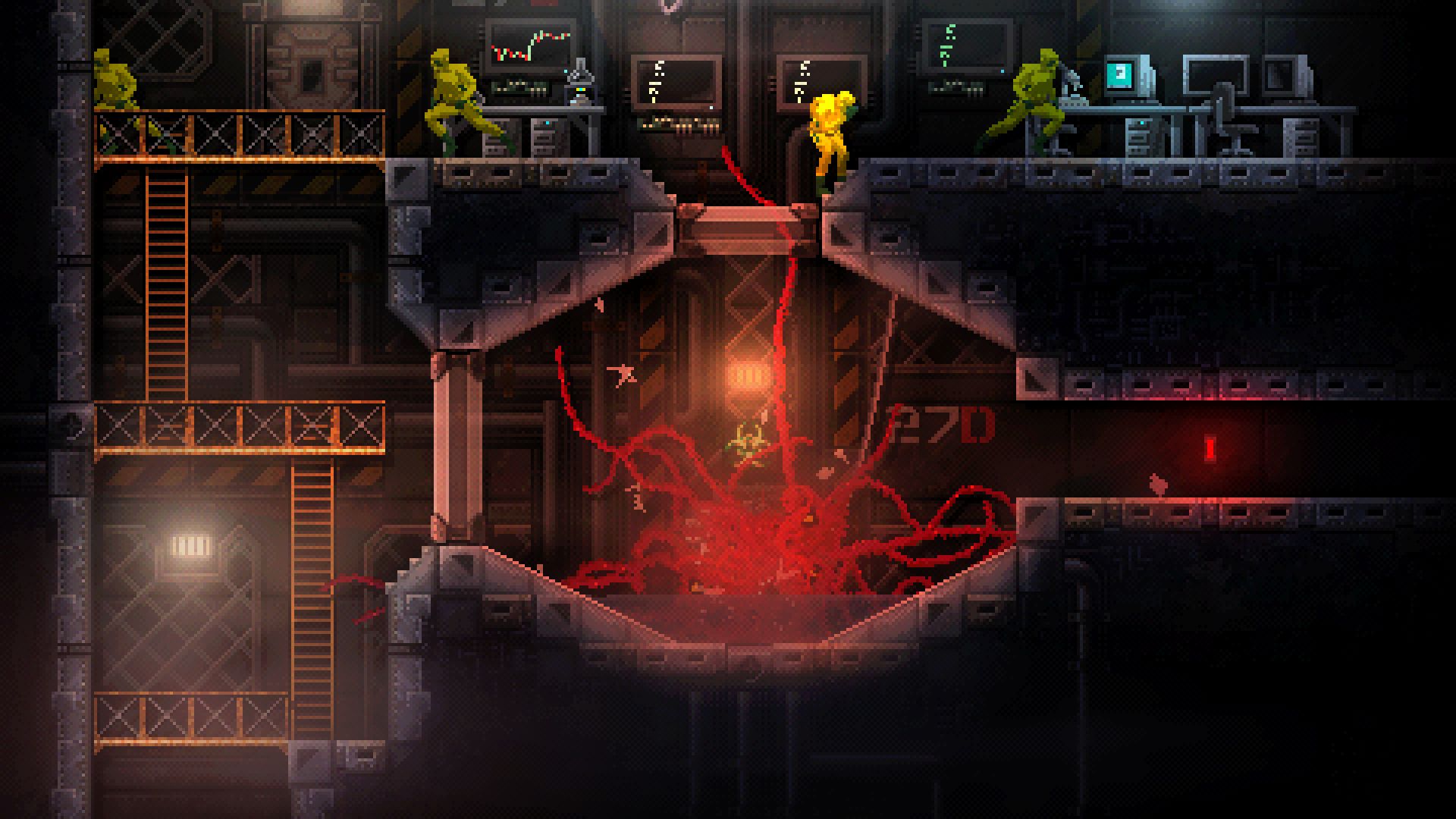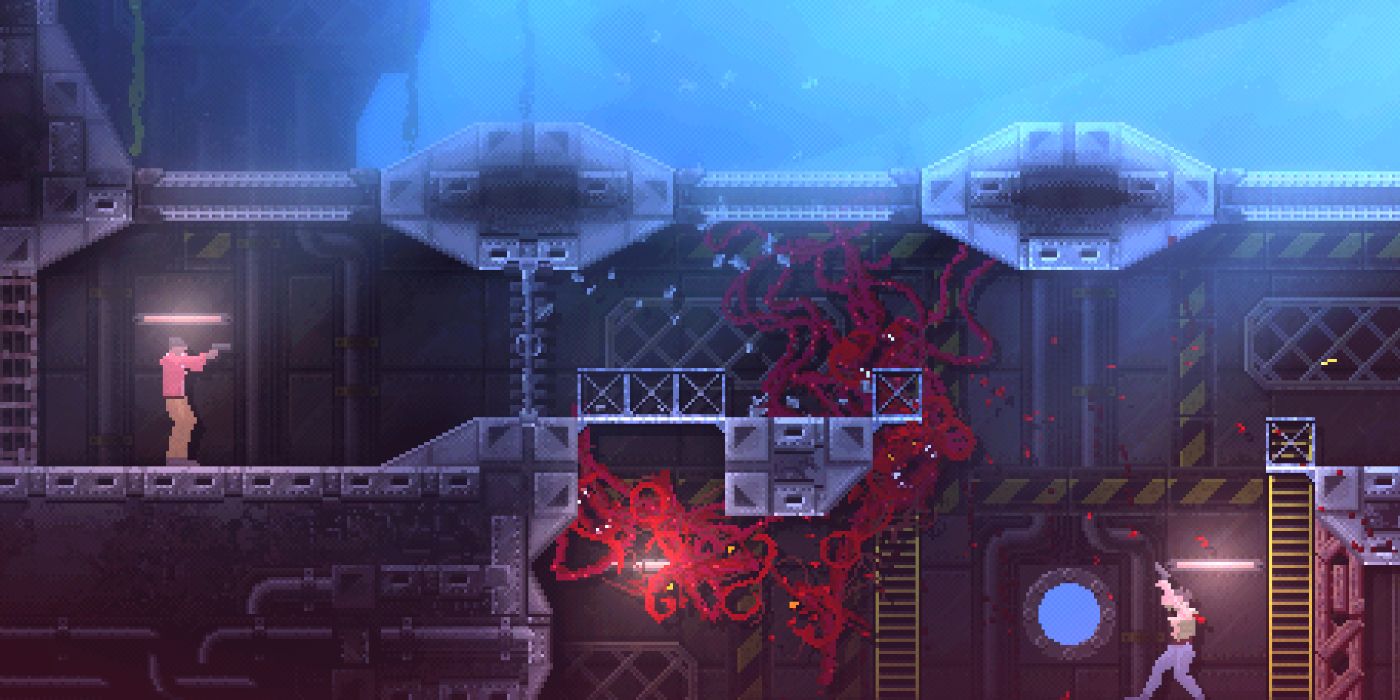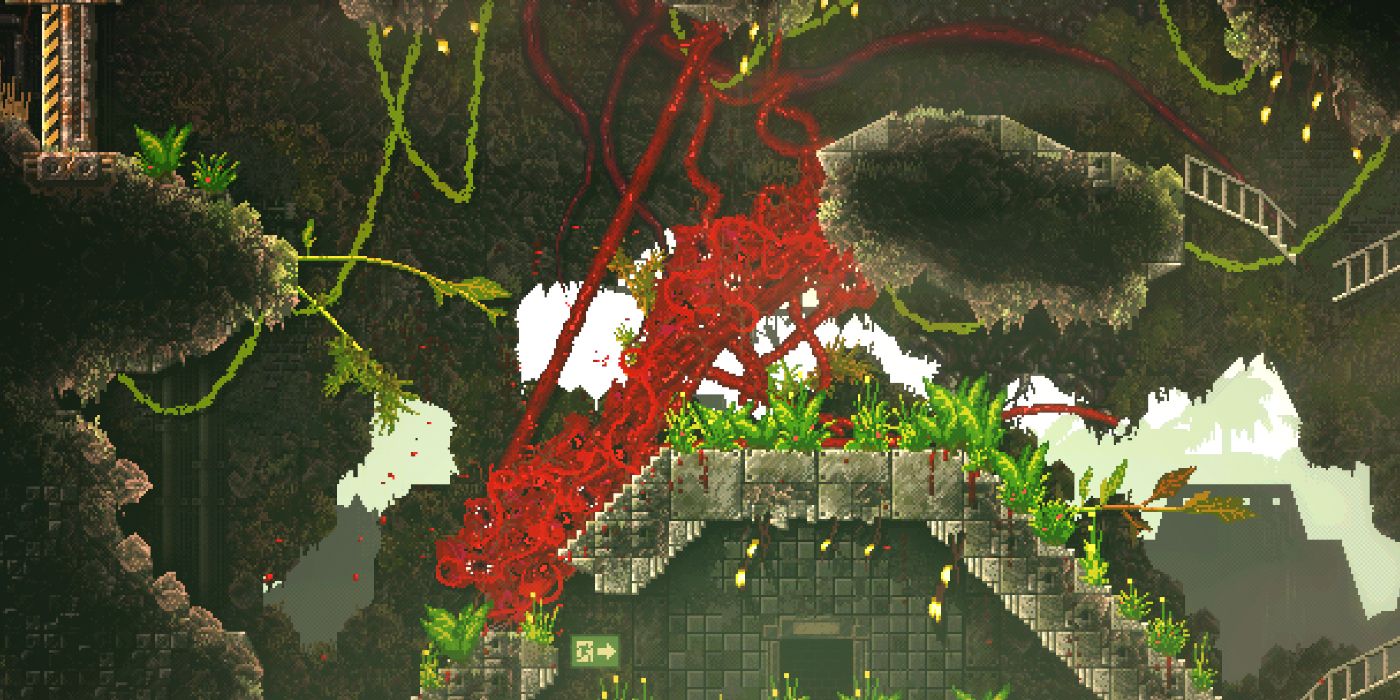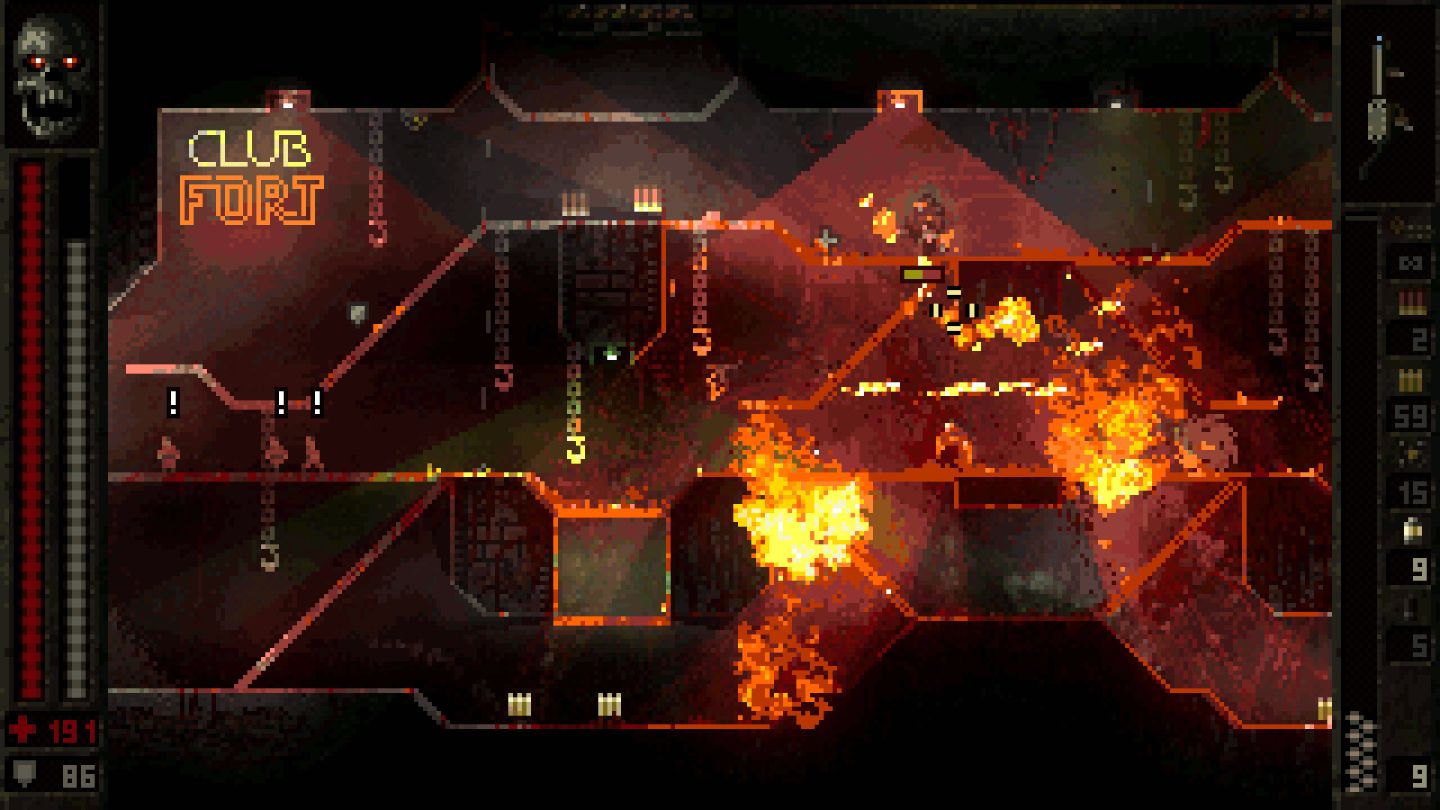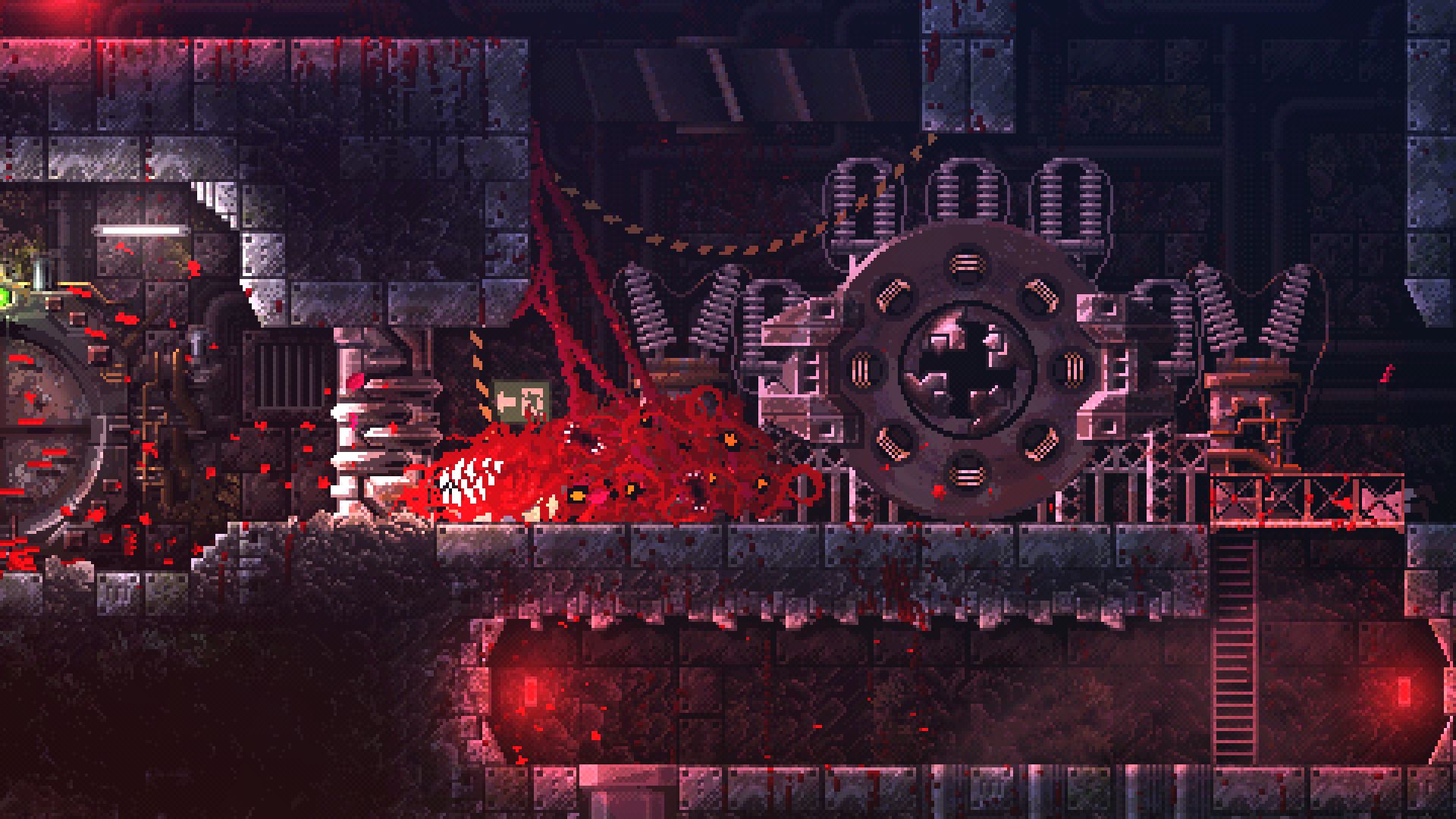In Devolver Digital’s upcoming release Carrion, it feels good to be the monster. Developed by Phobia Game Studio, Carrion lets players control a shambling blood-colored tentacled terror maneuvering through a science lab, terrifying and devouring every doomed employee in their wake. The game slots into the rarely-explored sub-genre of “reverse-horror,” blending this thematic approach with Metroidvania and puzzle-platforming gameplay.
Screen Rant got to chat with part of Phobia’s core team, developer Krzysztof Chomicki. The Polish studio gained early attention with their debut run-and-gun platformer Butcher, developed alongside Transhuman Design (King Arthur’s Gold, Soldat) and released in 2016. Butcher amassed a devoted fanbase with its unusual soundtrack, high challenge, 90s blood-and-guts aesthetic, and straightforward but relentless chunky-pixeled action, and the team’s follow-up crept its tendrils into teasers by 2018. Chomicki gets into some of these origins in the interview below.
Another critical aspect discussed is the audio engineering, which might steal the stage in Carrion. The slap of each tentacle to each surface, the churning murmurs of the creature, and the dark soundscape and occasional music that breaks through the wrecked lab’s ambiance adds captivating texture and personality, much like the best horror movies.
Could you introduce yourself to our readers, and describe the kind of work you've done on Carrion?
Krzysztof Chomicki: I’m the game and level designer for Carrion, so I designed the gameplay and mechanics. Sebastian [Krośkiewicz], he’s the game director and the main brains behind the whole project, and he also did all the programming and art. Plus, I did all the level design, pretty much. So, I did all the content, when it came to the architecture and puzzle design.
So it’s a two-man team?
Krzysztof Chomicki: Almost! We also have a pretty much full-time sound designer, plus the music and whole soundtrack was composed by Cris Velasco – you may know him from some AAA titles like Resident Evil 7, some of the God of War games, Mass Effect, Bloodborne, and so on. But you could say the core team is two or three guys.
I’ve played the demo, and I know that I’ve heard the term “reverse-horror” used a lot in the marketing, but how would you yourself describe Carrion?
Krzysztof Chomicki: Well, obviously I’d throw around the “reverse-horror” term, because it describes the reversal of the roles, in that you are this monster, this creature. But, other than that, I’d say it’s a cross between a 2D cinematic platformer and a metroidvania. It has a bit of both, but it’s not quite orthodox when it comes to any of these genres, it has some twists or deviations from the standard formula that makes it a bit different from your regular metroidvania or your regular – well, there aren’t that many cinematic platformers these days, but, you know, Another World, Flashback, and so on. So, yeah, something along those lines. I mean, it’s kind of a platformer without platforming!
How does growth work in the game? I see that when you consume people you get to a certain quote-unquote “level,” you get to a certain size. How do you guys envision that progression, or how its intended to work for the creature?
Krzysztof Chomicki: Once we had the basic prototype and we knew the general mechanics – like, okay, the monster eats, the monster grows, there will be some skills and so on – we designed what we called a “mass-based class system.” So, depending on your current size, you have access to different skills. So we have kind of those two systems. There is this regular, metroidvania-styled progression of just unlocking new skills but, when you have a new skill, it’s not just like, you always have it, and basically it’s just a new key to a new ability you can use any time you want. You [eventually] have to start actively managing your size. So, you don’t always want to be as large as possible. You have to start cycling between the different sizes, the different three classes.
So, yes, for this puzzle or combat situation, you may have to be this specific size. For example, you have to bypass some lasers so you have to get small and use the photokinesis skill to bypass the lasers; it’s a cloak, like The Predator, bending light so you can bypass lasers. But, for example, then you have a wooden obstacle, so you have to eat someone to get bigger and use the skill of the second class to dash through it, and so on.
We were [eventually] able to create some interesting puzzle situation set-ups without constantly giving you new skills. We keep the progression fresh throughout the whole game, you pretty much always get something new, but it’s not like, once you unlock it, that’s it. In most metroidvania-type games, you unlock the new weapon and use it the same way, and that’s kind of it. Have you played Soul Reaver 2?
Yeah, actually. I used to love the Soul Reaver games.
Krzysztof Chomicki: You remember the different Reavers? You had the air, fire, water, and had to cycle between them. It’s kind of similar. It wasn’t really inspired – I just thought of it now, these parallels – but it’s kind of similar. After you unlocked the new weapon or skill, it wasn’t always accessible to you, and you had to kind of work around that limitation. I think that creates some more interesting situations than if you always have everything [available] at the same time.
There wasn’t much in the way of story shared in the demo. Is the game concerned much with text narrative, or no?
Krzysztof Chomicki: No. There is some lore or reason behind everything, but we keep it as minimalistic as possible. It’s environmental storytelling, and we want the players to fill in the gaps and come up with their own theories. There are no text logs of survivors, [where players are] then spending half of the game reading or anything like that. We don’t have lengthy Kojima-styled cutscenes. It’s definitely through your experience, actions, and the environments you explore, plus some minor things in text, here and there, that you can piece together: the lore, the origins of the monster, and so on. But we avoid doing anything specific when it comes to the lore. We don’t want to do the Prometheus thing, overexplaining the alien.
It’s definitely more of a The Thing situation. Oh, it came from space, and that’s all you know, and the rest you can kind of figure out based on its actions. That’s the vibe we are going for, because ever since we revealed the game, people have started coming up with their own ideas for what the monster is, whether it’s an alien or a bunch of mutated worms, or maybe some leftover spaghetti that went bad over time. So we wanted to keep that vibe, only suggesting possible explanations, but not [performing] any sort of, “Now it’s exposition time,” with a half-hour of cutscenes.
That is the energy that’s released, I feel, in the demo. And I like that idea, because we have some strong examples of that. I’m thinking of Playdead games, who obviously have been one of the kings in that zone.
Krzysztof Chomicki: Funny thing about Inside is that I haven’t played it before we started working on Carrion but, once we revealed the monster, every second comment we saw was, “Oh, this is like Inside.” And I was like…thank you for spoiling Inside for me! I think, by now, everyone has played Inside, and I eventually did, but the funny thing is, it’s not that similar. There is some connection, but it’s very distant.
Right. And I’m also more specifically speaking of that philosophy, of telling a story without the reliance on text.
Krzysztof Chomicki: Yeah, that’s definitely it. The only text, there are some…well, I’m not going to spoil it, but there are some sequences where you actually do get a little bit of text, but it’s very short. Plus there are those dot matrix displays – you remember those screens in Abe's Oddysee? So, you have those screens with the text going around them, saying some funny stuff or gameplay hints. We have something similar throughout the facilities. Like, “All personnel go over there.” And if the player reads those, it gives some hints as to where to go, or sometimes it’s just some fun storytelling.
So, yeah, we definitely do the worldbuilding and all the lore, we just try to keep it as diegetic as possible. We don’t have quest logs popping up, or a pointer like, “go there and do this.” It’s definitely more minimalistic and old school in that sense.
You mentioned Abe's Oddysee. Are there any video games that you played or appreciate that may have influenced this in any way?
Krzysztof Chomicki: I have played Abe's Oddysee. I don’t think it was a strong influence, but you can find some parallels. Another World would be one, for sure. Especially that, kind of by accident, the human’s [animation] kind of has this vector style. They aren’t vector, but they kind of look like they are, so it gives us this Another World vibe, and I f—king love Another World.
I think, also, from a totally different set of games, all the FromSoftware Souls series. Dark Souls, Bloodborne. When it comes to level design, that was my main inspiration. They actually do have this sort of metroidvania vibe to them, but without a map and the backtracking isn’t that heavy. You almost always come across some shortcut or pathway, some new elevator, and so on. This is very similar to what we were going for, we didn’t want the backtracking to be, oh, every five minutes you have to go through half of the map back and forth to look for that single door that you can open now. It flows more naturally…though you can backtrack, and sometimes have to.
The single most important inspiration, I would say, is the Alien versus Predator games. The fact that you could play as the Xenomorph or The Predator. That was super awesome. Both Sebastian and I were basically raised on those games. The early 2000s games...not really the 2010 one. This [aspect] wasn’t really explored a lot. You have those multiplayer reverse-horror things – Dead by Daylight and whatever – where you can play as the villain, but it’s a totally different vibe, and you don’t have this single-player aspect to it, and that’s what we wanted to explore.
A villainous campaign.
Krzysztof Chomicki: Yeah. In fact, we tried to avoid outright specifying that you are the villain, so the player can kind of decide that, “Oh, the monster is the good guy.” We’re not necessarily framing it that way, but we avoid [outright stating it]. I mean, you were held captive, so it’s kind of fair that you go and f--k some s--t up.
Yeah! It’s a story of liberation.
Krzysztof Chomicki: Pretty much. That’s nicely put!
So then, on to the sounds of the game. The movement of the creature isn’t something I’ve seen in a 2D pixel-based game, where the tentacles automatically seem to always latch on to the right thing. And the sounds they make when they hit objectss or grab a person are intense. You said that someone is specifically working on the sound design; what else can you tell us about how sound works in the game?
Krzysztof Chomicki: Pretty much all the sounds we have were recorded by us, by our sound designer, so there’s little-to-no external libraries used, it’s pretty much all custom-made. For example, the sound of the tentacles, that’s just our sound designer whipping a USB cable, and it’s the sound of a cable cutting the air.
Yeah, so there’s lots of so-called foley in the sound design. You know, destroying glass and all kinds of fruit. There are also some animal sounds, like dogs that are very vocal about everything, they’re mixed into the monster’s roars and different sound effects during skills. Some human voices are mixed in, too. There are lots of layers to the sound effects, tens of different sounds used to achieve this alien vibe and make the monster seem powerful. You had the feel the impacts in the sound design.
Despite the game’s visuals being retro, I don’t think that if the sounds were also retro, chiptune-created, that probably wouldn’t work that well. So the sound design is definitely more in the AAA vibe, when it comes to production values, I’d say. And the same goes for the soundtrack.
We were inspired by different horror classics but, of them, the minimalistic symphonic sound of Alien – but [more so] the more brutal synths of John Carpenter. [Especially], in this case, The Thing. But also some non-horror inspirations, like Kryzstof Penderecki and his fairly modern approach to symphony. That’s one of the core inspirations behind the soundtrack. So, there’s lots of weirdly-played cellos that don’t follow usual melodies and so on. The game has a full-on OST which we’re going to release pretty soon, I think.
We paid a lot of attention to both the sound design and the music, which is why half of the team was working just on that, which I think is somewhat unusual for a small indie team like us.
Are you open to talking about expected game length, at this time?
Krzysztof Chomicki: It’s kind of hard to tell, to be honest. We don’t really have the right data on it. It’s not the type of game where the length is imposed by the mechanics. For example, in Doom or whatever, there is expected damage output you have, so there is only so fast you can go through the enemies or the environments without resorting to some speedrunning hacks and game-breaking bugs. And, in the case of Carrion, it vastly depends on how you play, or if you know the puzzles, or are very good at solving them, or don’t get lost. Most metroidvanias kind of have this problem of length, depending on whether you explore everything thoroughly or if you get lost. It’s hard to say. But it’s definitely not as long as Hollow Knight. Definitely under ten hours – I think it’s anything between four and eight hours, depending on your playstyle.
We didn’t want the game to be too long, because we wanted to keep the gameplay fresh and novel throughout the whole thing, and not make it a slog or boring grind. For example, what’s kind of unusual in metroidvania-inspired games is, we don’t have respawning enemies. So when you come back to a level and you killed someone there, he’s still dead. Because, you know, it would really undermine this power fantasy and the basis of this reverse horror if everyone just popped back alive.
Like, “I killed a room of scientists but they apparently just replenished them while I was gone.”
Krzysztof Chomicki: Yeah, yeah. So that also cuts down the playtime a bit, because you don’t have to keep running into the same enemies over and over when you’re backtracking, so it’s much more relaxing, in a way. But I think it also shows that you have an actual influence on the world, and if you kill someone, his corpse stays there…if you haven’t eaten them.
Right. You can just eat those legs later.
Krzysztof Chomicki: Yeah. Which, actually was quite difficult, technically, because of the save system. We have to save almost everything. Very often in metroidvanias, even in their puzzles, because they are so simple – use this weapon against this specific block or whatever – we can’t even respawn the puzzles very often. In our case, you have to save pretty much the whole level.
You have to save the corpses.
Krzysztof Chomicki: Yeah. Save the corpses, save the obstacles, how they broke, where they’re lying around. Pretty much everything that you can interact with in a tangible way is saved. We’re saving lots and lots of data in these saves, so that was quite challenging.
Tell me a little about the background of the core Phobia Games duo.
Krzysztof Chomicki: Our previous game, done with pretty much the same core team, including the sound designer – although [back] then he was also acting as the composer for the game – we did Butcher. A similar setup there, in that you’re playing a bad guy. It was Terminator-inspired. It was under a different company, produced and published by Transhuman Design. After King Arthur’s Gold’s success, Michał Marcinkowski decided to expand and do several projects at once. I joined the team as a level designer, then we found Maciej Niedzelski to do the music.
It’s kind of a funny story: our initial gut feeling or instinct for the music for Butcher was to go for some metal; death metal or some industrial metal. And it was kind of okay when we tried out the metal tracks, but it wasn’t quite it. We were looking for something specific which we couldn’t really name.
Eventually, after long, long nights of searching for a genre, I remembered a kind of distant friend of mine showed me a band called Sui Generis Umbra, which was this Polish band doing gothic/industrial electro, kind of…it was weird music, but when we tried it with Butcher were like, “this is it!” We contacted the keyboardist, who turned out to be the main composer of their tracks, and that was Maciej, and we brought him on board. It turned out that he always wanted to do music for video games, and we got him into the industry. He’s now doing the sound design for Carrion and some small ambient tracks, but Velasco is doing the music.
The game’s release is right around the corner now. How long has it been in development?
Krzysztof Chomicki: Three years. I think it was June 2017 when Sebastian started working on some prototypes with the monster moving around. Back then it was more like a Katamari, in that you just run into people and consume them automatically, which was kind of fun, but it was five-minutes fun and not five-hours fun. So yeah, that had to be changed.
Funny enough, the GIF from that era surfaced on 9GAG or Reddit several times. [It was a crude] GIF but people were getting excited by it. We were like, maybe we should keep those graphics as minimalistic as possible? The humans were basically white paper cutouts with no animations, with slight moving animations. It was fun.
That was three years ago. After a couple of months of Sebastian messing around with the movement mechanics and the general idea of eating people and growing larger, that’s when we decided to take it all and put it into a vertical slice prototype, which we showcased at GDC 2018, and also sent it to different publishers. That was a good strategy, because that’s how we were able to strike a deal with Devolver, because they liked the demo.
The tentacles were one of the first things we developed. The basic movement mechanics haven’t really changed, but polishing and tweaking all the mechanics took years to get right; we’ve even tweaked it and improved it past the Alpha demo that you played. The physics are simple, but getting them to feel good and work on both mouse and keyboard and controllers? That took a lot of effort.
Carrion releases on PC/Windows, Nintendo Switch, and Xbox One on July 23.

